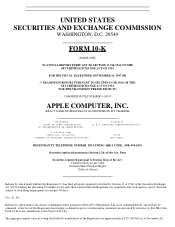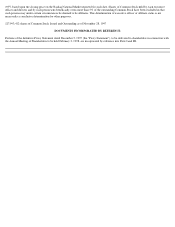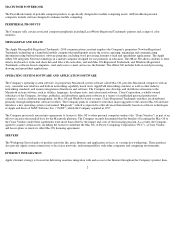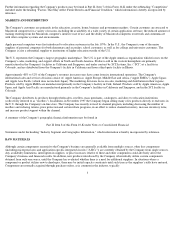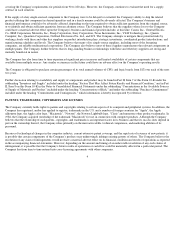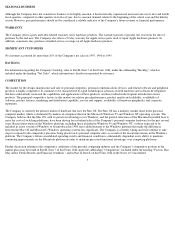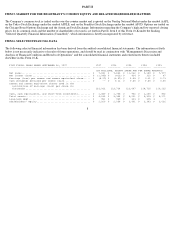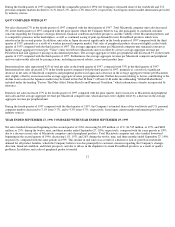Apple 1997 Annual Report Download - page 12
Download and view the complete annual report
Please find page 12 of the 1997 Apple annual report below. You can navigate through the pages in the report by either clicking on the pages listed below, or by using the keyword search tool below to find specific information within the annual report.ITEM 7. MANAGEMENT'S DISCUSSION AND ANALYSIS OF FINANCIAL CONDITION AND RESULTS OF OPERATIONS
THIS SECTION AND OTHER PARTS OF THIS FORM 10-K CONTAIN FORWARD-LOOKING STATEMENTS THAT INVOLVE
RISKS AND UNCERTAINTIES. THE COMPANY'S ACTUAL RESULTS MAY DIFFER SIGNIFICANTLY FROM THE RESULTS
DISCUSSED IN THE FORWARD-LOOKING STATEMENTS. FACTORS THAT MIGHT CAUSE SUCH DIFFERENCES INCLUDE,
BUT ARE NOT LIMITED TO, THOSE DISCUSSED IN THE SUBSECTION ENTITLED "FACTORS THAT MAY AFFECT OPERATING
RESULTS AND FINANCIAL CONDITION" BELOW.
THE FOLLOWING DISCUSSION SHOULD BE READ IN CONJUNCTION WITH THE CONSOLIDATED FINANCIAL STATEMENTS
AND NOTES THERETO INCLUDED ELSEWHERE IN THIS FORM 10-K. ALL INFORMATION IS BASED ON THE COMPANY'S
FISCAL CALENDAR.
OVERVIEW
During 1997, the Company continued to experience declines in net sales, units shipped and share of the personal computer market compared to
prior years. The decline in demand and the resulting losses, coupled with intense price competition throughout the industry, led to the
Company's decision to continue to restructure its business during 1997 aimed at reducing its core structure, improving its competitiveness and
restoring sustainable profitability. The Company's restructuring efforts have included significant headcount reductions, simplifications and
modifications of the Company's product lines, increases in the proportion of products manufactured under outsourcing arrangements and the
implementation of an on-line store in the U.S. In addition, the Company plans to increase the proportion of products manufactured on a made-
to-
order basis The Company believes that restructuring actions effected through the fourth quarter of 1997, as well as those currently planned to
be effected during 1998, will decrease operating expenses in 1998 compared with 1997. There is no assurance that such decreases in operating
expenses will be achieved or that, if achieved, such reductions will be sufficient to offset the decline in the Company's net sales.
In February 1997, the Company acquired NeXT. NeXT developed, marketed and supported software that enables customers to implement
business applications on the Internet/World Wide Web, intranets and enterprise-
wide client/server networks. The acquisition was accounted for
as a purchase and, accordingly, the operating results pertaining to NeXT subsequent to the date of acquisition have been included in the
Company's consolidated operating results. The total purchase price, including the fair value of the net liabilities assumed, was $427 million of
which $375 million was allocated to purchased in-process research and development and $52 million was allocated to goodwill and other
intangible assets. The purchased in-process research and development was charged to operations upon acquisition, and the goodwill and other
tangible assets are being amortized on a straight-line basis over two years.
The Company had previously entered into agreements to license its Mac OS to other personal computer vendors (the "Clone Vendors") as part
of an effort to increase the installed base for the Macintosh platform. The Company recently determined that the benefits of licensing the Mac
OS to the Clone Vendors under these agreements were more than offset by the impact and costs of the licensing program. As a result, the
Company agreed to acquire certain assets, including the license to distribute the Mac OS, of PCC, a clone vendor, and has no plans to renew its
other Mac OS licensing agreements.
The Company's future operating results and financial condition are dependent upon the Company's ability to successfully develop,
manufacture, and market technologically innovative products in order to meet dynamic customer demand patterns, and are also dependent upon
its ability to effect a change in marketplace perception of the Company's prospects, including the viability of the Macintosh platform. Inherent
in this process are a number of factors that the Company must successfully manage in order to achieve favorable future operating results and a
favorable financial condition. Potential risks and uncertainties that could affect the Company's future operating results and financial condition
include, among other things, continued competitive pressures in the marketplace and the effect of any reaction by the Company to such
competitive pressures, including pricing actions by the Company; the availability of key components on terms acceptable to the Company; the
Company's ability to supply products in certain categories; the Company's ability to supply products free of latent defects or other faults; the
Company's
9


